2018 MERCEDES-BENZ CLA spare tire
[x] Cancel search: spare tirePage 291 of 326
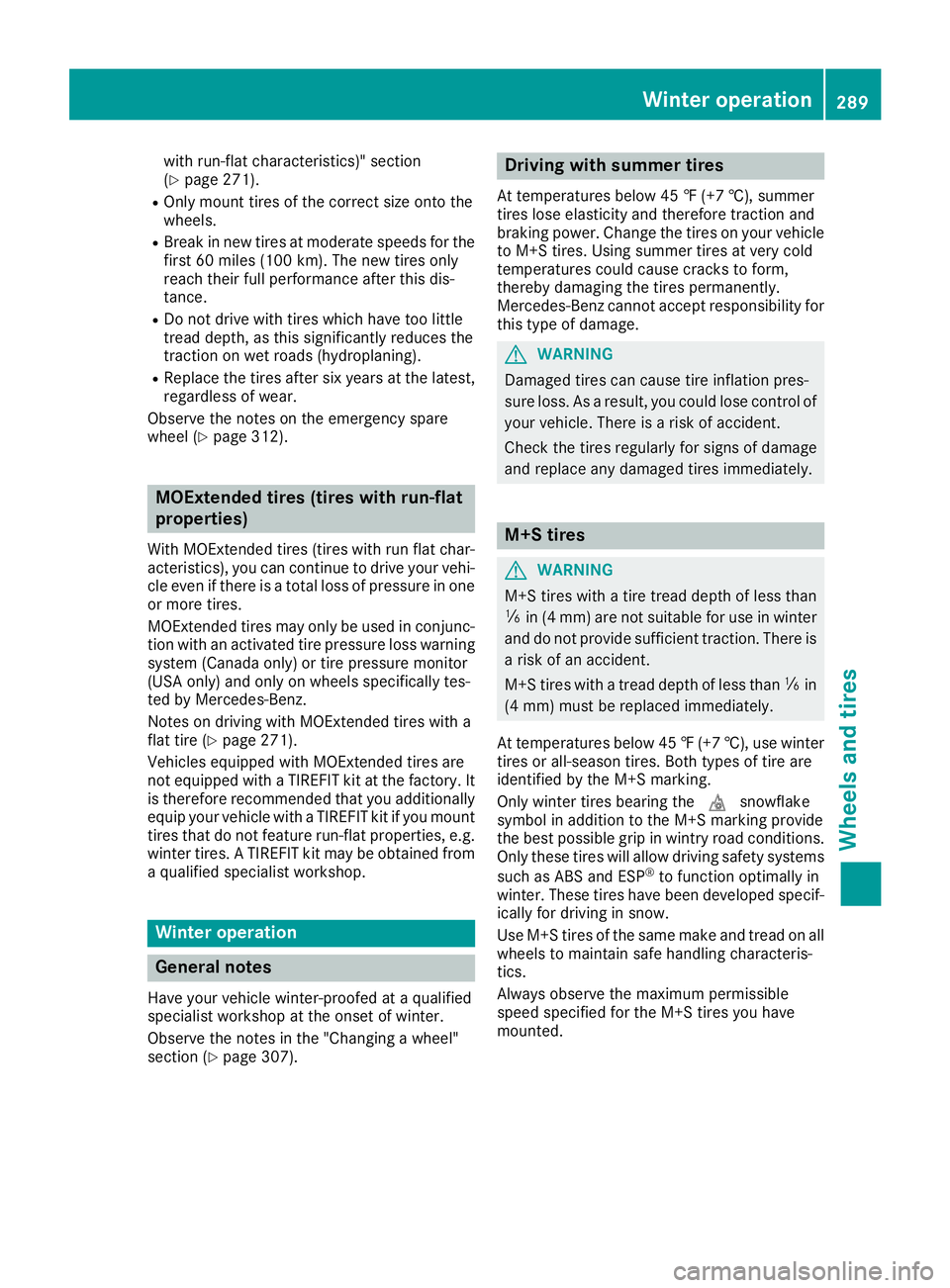
with run-flat characteristics) "s ection
( Y
page 271). R
Only moun tt ires of th ec orrec ts iz eo nt ot he
wheels. R
Break in new tires at moderat es peeds for the
firs t6 0m iles (10 0k m) .T he ne wt ires only
reac ht he ir full performanc ea fter this dis-
tance. R
Do not driv ew ith tires which have too little
tread depth, as this significantly reduces the
traction on wet roads (hydroplaning). R
Replace th et ires after six years at th el atest,
regardless of wear.
Observe th en otes on th ee mergency spare
wheel ( Y
page 312).
MOExtended tires (tires with run-flat
properties) With MOExtended tires (tires with run flat char-
acteristics) ,y ou can continue to driv ey our vehi-
cle even if there is at otal loss of pressure in one
or mor et ires.
MOExtended tires may only be used in conjunc-
tio nw ith an activated tir ep ressure loss warning
system (Canada only) or tir ep ressure monitor
(US Ao nly) and only on wheels specifically tes-
ted by Mercedes-Benz.
Notes on driving with MOExtended tires with a
flat tir e( Y
page 271).
Vehicles equipped with MOExtended tires are
not equipped with aT IREFIT kit at th ef actory. It
is therefore recommended that you additionally
equip your vehicle with aT IREFIT kit if you mount
tires that do not feature run-flat properties, e.g.
winter tires. AT IREFI Tk it may be obtained from
aq ualified specialist workshop.
Winter operation
General notes Have your vehicle winter-proofed at aq ualified
specialist workshop at th eo nset of winter.
Observe th en otes in th e" Changing aw heel"
sectio n( Y
page 307). Driving with summer tires At temperatures below 45 ‡( +7 †) ,s umme r
tire sl os ee las ti cit ya nd therefore traction and
braking power .C hange th et ires on your vehicle
to M+S tires. Usin gs ummer tires at ver yc old
temperatures coul dc aus ec ra ck stof orm,
thereb yd amaging th et ires permanently.
Mercedes-Ben zc anno ta ccept responsibilit yf or
this type of damage.
G WARNING
Damaged tires can caus et ir ei nflation pres-
sure loss .Asar esult, you coul dl ose control of
your vehicle .T her eisar isk of accident.
Chec kt he tires regularly for sign sofd amage
and replace any damage dt ires immediately.
M+S tires
G WARNING
M+S tires with at ir et re ad dept hofl ess than
�
Page 292 of 326
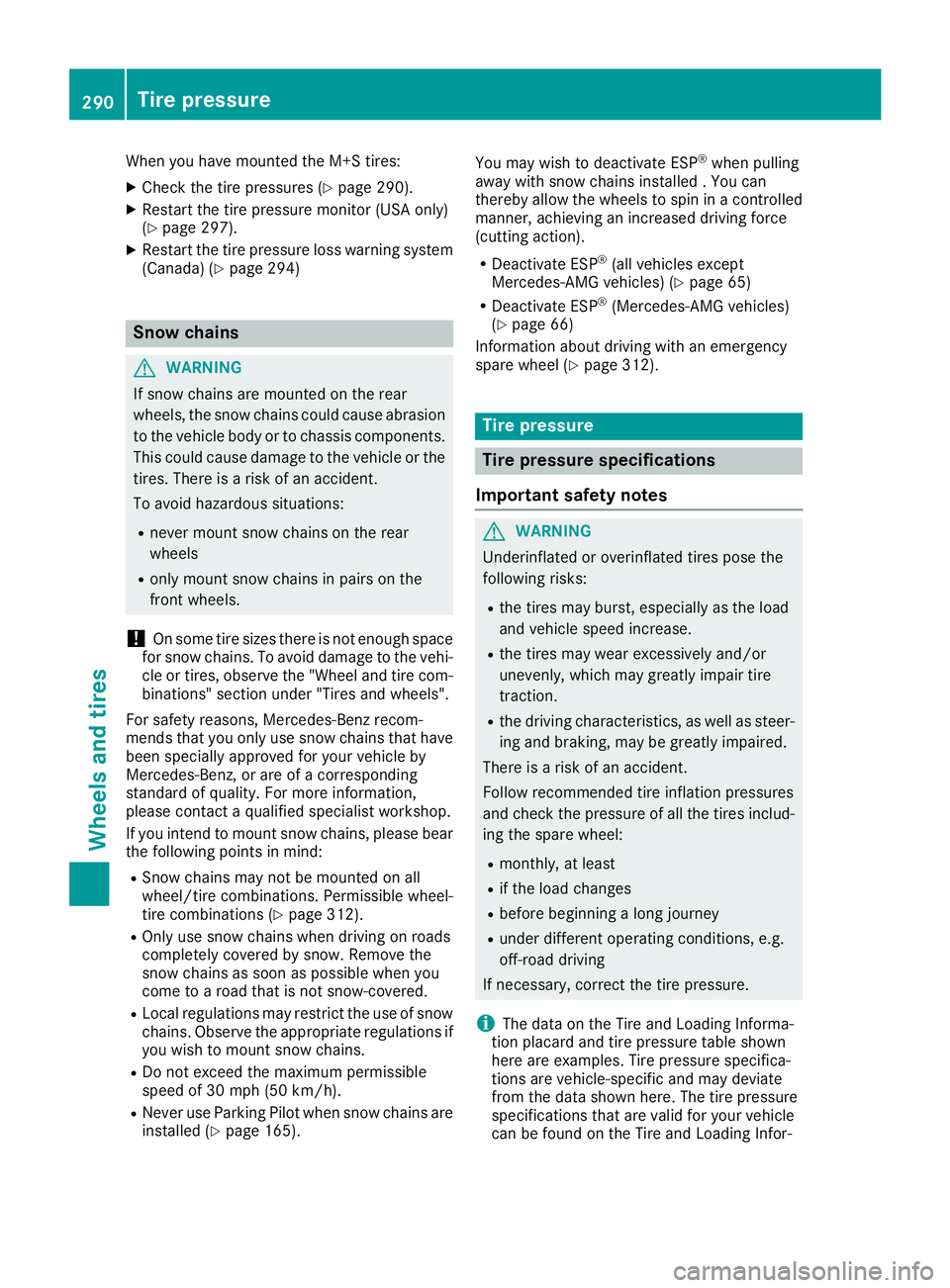
When you have mounted the M+S tires: X
Check the tire pressures ( Y
page 290).X
Restart the tire pressure monitor (USA only)
( Y
page 297).X
Restart the tire pressure loss warning system
(Canada) ( Y
page 294)
Snow chains
G WARNING
If snow chains are mounted on the rear
wheels, the snow chains could cause abrasion
to the vehicle body or to chassis components.
This could cause damage to the vehicle or the
tires. There is ar isk of an accident.
To avoid hazardous situations: R
never mount snow chains on the rear
wheels R
only mount snow chains in pairs on the
fron tw heels.
! On some tire sizes there is not enough space
for snow chains. To avoid damage to the vehi-
cle or tires, observe the "Wheel and tire com-
binations" section under "Tires and wheels".
For safety reasons, Mercedes-Benz recom-
mends that you only use snow chains that have
been specially approved for your vehicle by
Mercedes-Benz ,ora re of ac orresponding
standard of quality. For more information,
please contact aq ualified specialist workshop.
If you inten dtom ount snow chains, please bear
the following points in mind: R
Sno wc hains may not be mounted on all
wheel/tire combinations. Permissible wheel-
tire combinations ( Y
page 312).R
Only use snow chains when driving on roads
completely covered by snow. Remove the
snow chains as soon as possible when you
come to ar oad that is not snow-covered.R
Local regulations may restrict the use of snow
chains. Observe the appropriate regulations if
you wish to mount snow chains. R
Do not exceed the maximum permissible
speed of 30 mph (50 km/h). R
Never use Parking Pilot when snow chains are
installed ( Y
page 165). You may wish to deactivat eE SP ®
when pulling
away with snow chains installed .Y ou can
thereby allow the wheels to spin in ac ontrolled
manner, achieving an increased driving force
(cutting action). R
Deactivate ESP ®
(all vehicles except
Mercedes-AMG vehicles) ( Y
page 65)R
Deactivate ESP ®
(Mercedes-AMG vehicles)
( Y
page 66)
Information about driving with an emergency
spare wheel ( Y
page 312).
Tir ep re ssure
Tir ep re ssure specifications
Important safety notes
G WARNING
Underinflated or overinflated tires pose the
following risks: R
the tires may burst, especially as the load
and vehicle speed increase. R
the tires may wear excessively and/or
unevenly, which may greatly impair tire
traction. R
the driving characteristics, as well as steer-
ing and braking, may be greatly impaired.
There is ar isk of an accident.
Follow recommended tire inflation pressures
and check the pressure of all the tires includ-
ing the spare wheel: R
monthly, at least R
if the load changes R
before beginnin gal ong journeyR
under differen to perating conditions, e.g.
off-road driving
If necessary, correct the tire pressure.
i The data on the Tire and Loading Informa-
tion placard and tire pressure table shown
here are examples. Tire pressure specifica-
tions are vehicle-specific and may deviate
from the data shown here. The tire pressure
specifications that are valid for your vehicle
can be found on the Tire and Loading Infor-290
Tir ep re ssure
Wheels and tires
Page 293 of 326

mation placard and tire pressure table on the
vehicle.
General notes The recommended tire pressures for the tires
mounted at the factory can be found on the
labels described here.
Operation with an emergency spare wheel:
informatio nono peration with an emergency
spare whee lc an be found in the general notes in
the "Emergency spare wheel" section
( Y
page 312).
Further informatio nont ire pressures can be
obtained at aq ualified specialist workshop.
Tire and Loading Information placard
�C
Recommended tire pressures
The Tire and Loading Information placard is on
the B-pillar on the driver' ss ide ( Y
page 298).
The Tire and Loading Information placard con-
tains the recommended tire pressures for cold
tires. The recommended tire pressures are valid
for the maximu mp ermissibl el oa da nd up to the
maximu mp ermissibl ev ehicl es peed.
Tire pressure table The tire pressure table is on the inside of the fuel
filler flap .Its hows the tire pressure for all tires
permitted at the factory for this vehicle; see
illustratio n( example). The tire pressure table contains the recommen-
ded pressures for cold tires for various operat-
ing conditions, i.e. differing loa da nd speed con-
ditions.
If at ire size precede sat ire pressure, the fol-
lowing tire pressure informatio niso nly vali df or
that tire size; see illustratio n( example).
The loa dc onditions "partiall yl aden" and "fully
laden" are defined in the table for different num-
bers of occupants and amounts of luggage .T he
actua ln umber of seats may differ.
Some tire pressure table ss how only the rim
diameters instead of the full tire size, e.g. R18 .
Rim diameter is part of the tire size and can be
found on the tire sidewal l( Y
page 302).Tire pressure 291
Wheel sa nd tires Z
Page 294 of 326
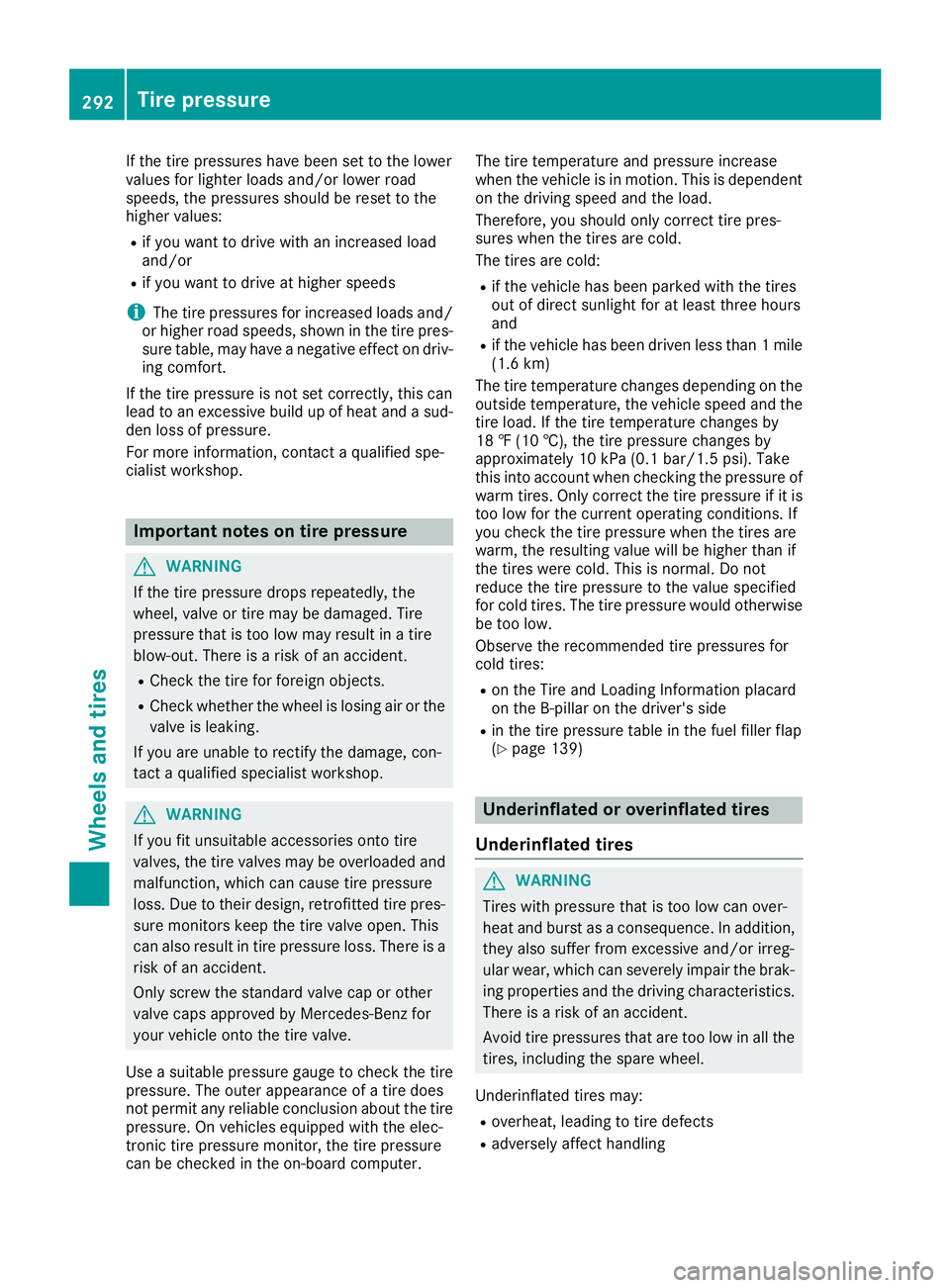
If the tire pressures have been set to the lower
values for lighter load sa nd/or lowe rr oad
speeds, the pressures shoul dber eset to the
higher values: R
if you want to drive with an increased load
and/or R
if you want to drive at higher speeds
i The tire pressures for increased load sa nd/
or higher road speeds, shown in the tire pres-
sure table, may have an egative effect on driv-
ing comfort.
If the tire pressure is not set correctly, this can
lea dtoane xcessive build up of heat and as ud-
den loss of pressure.
For more information, contact aq ualifie ds pe-
cialist workshop.
Important notes on tire pressure
G WARNING
If the tire pressure drops repeatedly ,t he
wheel ,v alve or tire may be damaged. Tire
pressure that is too low may resul tina tire
blow-out. There is ar isk of an accident.R
Check the tire for foreign objects. R
Check whether the wheel is losing air or the
valve is leaking.
If you are unabl etor ectify the damage, con-
tact aq ualifie ds pecialist workshop.
G WARNING
If you fit unsuitable accessorie so nto tire
valves ,t he tire valves may be overloaded and
malfunction, which can cause tire pressure
loss. Due to their design, retrofitted tire pres-
sure monitors keep the tire valve open. This
can also resul tint ire pressure loss. There is a
risk of an accident.
Only screw the standard valve cap or other
valve caps approved by Mercedes-Benz for
you rv ehicle onto the tire valve.
Use as uitable pressure gauge to check the tire
pressure. The outer appearance of at ire does
not permit any reliable conclusion abou tt he tire
pressure. On vehicle se quipped with the elec-
tronic tire pressure monitor, the tire pressure
can be checked in the on-board computer. The tire temperature and pressure increase
when the vehicle is in motion. This is dependent
on the driving speed and the load.
Therefore, you shoul do nly correct tire pres-
sures when the tires are cold.
The tires are cold: R
if the vehicle has been parked with the tires
out of direct sunlight for at least three hours
and R
if the vehicle has been driven less than 1m ile
(1.6 km)
The tire temperature changes depending on the
outsid et emperature ,t he vehicle speed and the
tire load .Ift he tire temperature changes by
18 ‡( 10 †), the tire pressure changes by
approximately 10 kPa (0.1 bar/1.5 psi) .T ake
this into account when checking the pressure of
warm tires. Only correct the tire pressure if it is
too low for the current operating conditions. If
you check the tire pressure when the tires are
warm, the resulting valu ew il lbeh ighe rt han if
the tires were cold. This is normal. Do not
reduce the tire pressure to the valu es pecified
for cold tires. The tire pressure would otherwise
be too low.
Observe the recommended tire pressures for
cold tires: R
on the Tire and Loading Information placard
on the B-pilla ront he driver's sideR
in the tire pressure table in the fuel fille rf lap
( Y
page 139)
Underinflated or overinflated tires
Underinflated tires
G WARNING
Tires with pressure that is too low can over-
heat and burst as ac onsequence. In addition,
they also suffer from excessive and/or irreg-
ula rw ear, which can severel yi mpair the brak-
ing propertie sa nd the driving characteristics.
There is ar isk of an accident.
Avoid tire pressures that are too low in all the
tires, including the spare wheel.
Underinflated tires may: R
overheat, leading to tire defects R
adversely affect handling292
Tire pressure
Wheel sa nd tires
Page 297 of 326

shown in the Serv. menu of the multifunction
display, see illustration (example).
For information on the message display, refer to
the "Checking the tire pressure electronically"
section ( Y
page 296).
Important safety notes
G WARNING
Each tire, including the spare (if provided),
should be checked at least once every two
weeks when cold and inflated to the pressure
recommended by the vehicle manufacturer
on the Tire and Loading Information placard
on the driver's door B-pillar or the tire pres-
sure label on the inside of the fuel filler flap. If
your vehicle has tires of ad ifferent size than
the size indicated on the Tire and Loading
Information placard or, if available, the tire
pressure label ,y ou should determine the
proper tire pressure for those tires.
As an added safety feature, your vehicle has
been equipped with at ire pressure monitoring
system (TPMS) that illuminates al ow tire pres-
sure telltale when one or more of your tires
are significantly underinflated. Accordingly,
when the low tire pressure telltale lights up,
you should stop and check your tires as soon
as possible ,a nd inflate them to the proper
pressure. Driving on as ignificantly underin-
flated tire causes the tire to overheat and can
lead to tire failure.
Underinflation also reduces fuel efficiency
and tire tread life, and may affect the vehicle's
handling and stopping ability. Please note that
the TPMS is not as ubstitute for proper tire
maintenance, and it is the driver's responsi-
bility to maintain correct tire pressure, even if
underinflation has not reached the level to trigger illumination of the TPMS low tire pres-
sure telltale.
Your vehicle has also been equipped with a
TPMS malfunction indicator to indicate when
the system is not operating properly. The
TPMS malfunction indicator is combined with
the low tire pressure telltale. When the sys-
tem detects am alfunction, the warning lamp
will flash for approximately am inute and then
remain continuously illuminated. This
sequence will be repeated every time the vehi-
cle is started as long as the malfunction
exists. When the malfunction indicator is illu-
minated, the system may not be able to detect
or signal low tire pressure as intended.
TPMS malfunctions may occur for av ariety of
reasons, including the installation of incom-
patible replacement or alternate tires or
wheels on the vehicle that prevent the TPMS
from functionin gp roperly. Always check the
TPMS malfunction telltale after replacing one
or more tires or wheels on your vehicle to
ensure that the replacement or alternate Tires
and wheels allow the TPMS to continue to
function properly.
It is the driver's responsibility to set the tire
pressure to that recommended for cold tires
which is suitable for the operating situation
( Y
page 290). Note that the correct tire pressure
for the current operating situation must first be
taught-in to the tire pressure monitor. If as ub-
stantial loss of pressure occurs, the warning
threshold for the warning message is aligned to
the taught-in reference values. Restart the tire
pressure monitor after adjusting the pressure of
the cold tires ( Y
page 297). The current pres-
sures are saved as new reference values. As a
result, aw arning message will appea rift he tire
pressure drops significantly.
The tire pressure monitor does not warn you of
an incorrectly set tire pressure. Observe the
notes on the recommended tire pressure
( Y
page 290).
The tire pressure monitor is not able to warn you
of as udden loss of pressure, e.g. if the tire is
penetrated by af oreign object. In the event of a
sudden loss of pressure, bring the vehicle to a
halt by braking carefully .A void abrupt steering
movements. Tire pressure 295
Wheels and tires Z
Page 298 of 326
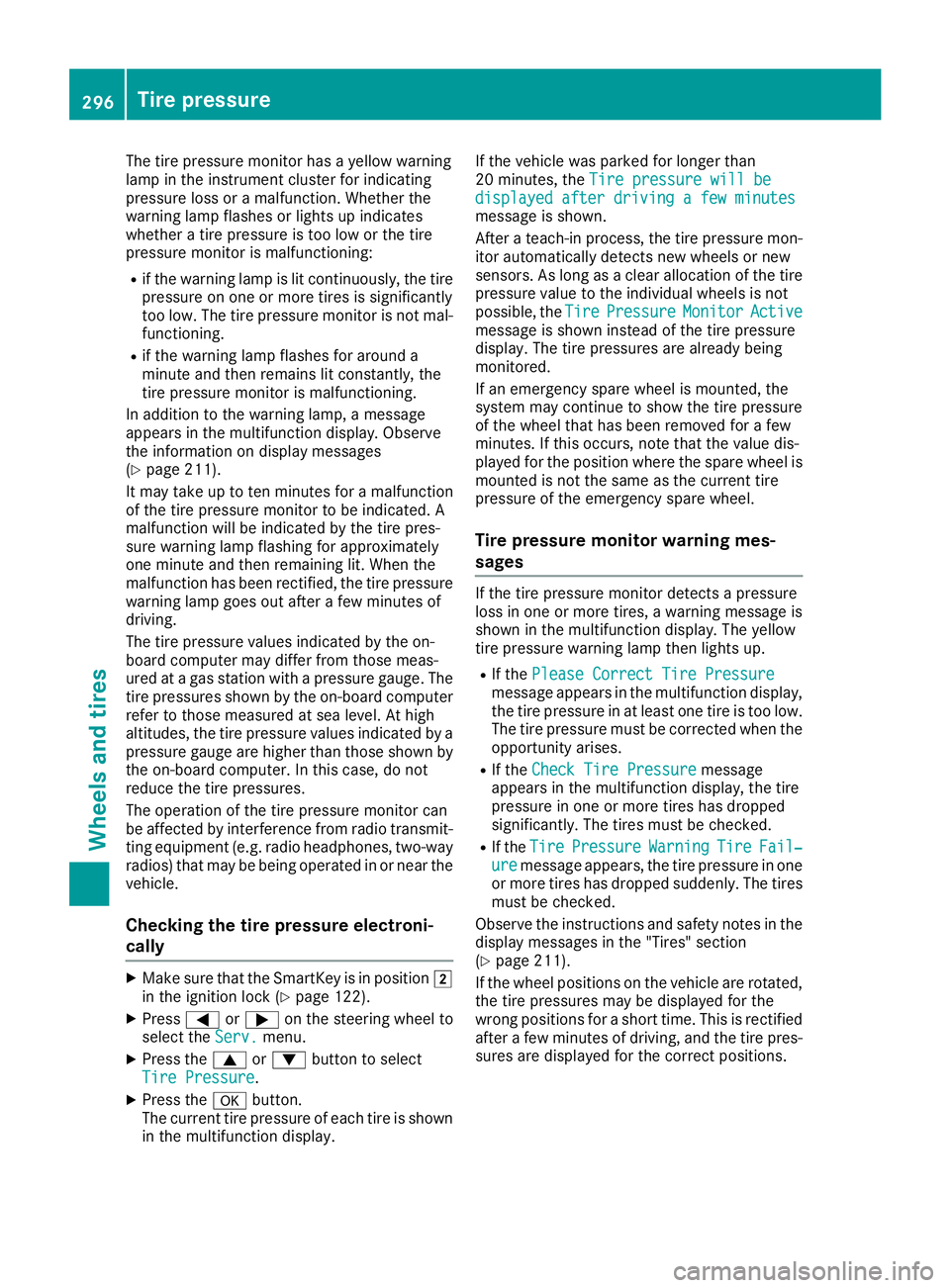
The tire pressure monitor has ay ellow warning
lamp in the instrument cluster for indicating
pressure loss or am alfunction. Whether the
warning lamp flashes or lights up indicates
whether at ire pressure is too low or the tire
pressure monitor is malfunctioning: R
if the warning lamp is lit continuously, the tire
pressure on one or more tires is significantly
too low. The tire pressure monitor is not mal-
functioning. R
if the warning lamp flashes for around a
minute and then remains lit constantly, the
tire pressure monitor is malfunctioning.
In addition to the warning lamp, am essage
appears in the multifunction display .O bserve
the information on display messages
( Y
page 211).
It may take up to ten minutes for am alfunction
of the tire pressure monitor to be indicated. A
malfunction will be indicated by the tire pres-
sure warning lamp flashing for approximately
one minute and then remaining lit. When the
malfunction has been rectified, the tire pressure
warning lamp goes out after af ew minutes of
driving.
The tire pressure values indicated by the on-
board computer may differ from those meas-
ured at ag as station with ap ressure gauge. The
tire pressures shown by the on-board computer
refer to those measured at sea level. At high
altitudes, the tire pressure values indicated by a
pressure gauge are higher than those shown by
the on-board computer. In this case, do not
reduce the tire pressures.
The operation of the tire pressure monitor can
be affected by interferenc ef rom radio transmit-
ting equipment (e.g. radio headphones, two-way
radios) that may be being operated in or near the
vehicle.
Checking the tire pressur ee lectroni-
cally X
Make sure that the SmartKey is in position �H
in the ignition lock ( Y
page 122).X
Press �Y or �e on the steerin gw heel to
select the Serv. menu.X
Press the �c or �d button to select
Tire Pressure .X
Press the �v button.
The current tire pressure of each tire is shown
in the multifunction display. If the vehicle was parked for longer than
20 minutes, the Tire pressure will be
displayed after driving af ew minutes
message is shown.
After at each-in process, the tire pressure mon-
itor automatically detect sn ew wheels or new
sensors. As long as ac lear allocation of the tire
pressure value to the individual wheels is not
possible, the Tire Pressure Monitor Active
message is shown instead of the tire pressure
display .T he tire pressures are already being
monitored.
If an emergenc ys pare wheel is mounted, the
system may continue to show the tire pressure
of the wheel that has been removed for af ew
minutes. If this occurs, not et hat the value dis-
played for the position where the spare wheel is
mounted is not the same as the current tire
pressure of the emergenc ys pare wheel.
Tire pressur em onitor warning mes-
sages If the tire pressure monitor detect sap ressure
loss in one or more tires, aw arning message is
shown in the multifunction display .T he yellow
tire pressure warning lamp then lights up. R
If the Please Correct Tire Pressure
message appears in the multifunction display,
the tire pressure in at least one tire is too low.
The tire pressure must be corrected when the
opportunit ya rises. R
If the Check Tire Pressure message
appears in the multifunction display ,t he tire
pressure in one or more tires has dropped
significantly. The tires must be checked. R
If the Tire Pressure Warning Tire Fail‐
ure message appears, the tire pressure in one
or more tires has dropped suddenly. The tires
must be checked.
Observe the instructions and safety notes in the
display messages in the "Tires" section
( Y
page 211).
If the wheel positions on the vehicle are rotated,
the tire pressures may be displayed for the
wrong positions for as hort time. This is rectified
after af ew minutes of driving, and the tire pres-
sures are displayed for the correc tp ositions.296
Tir ep re ssure
Wheels and tires
Page 308 of 326
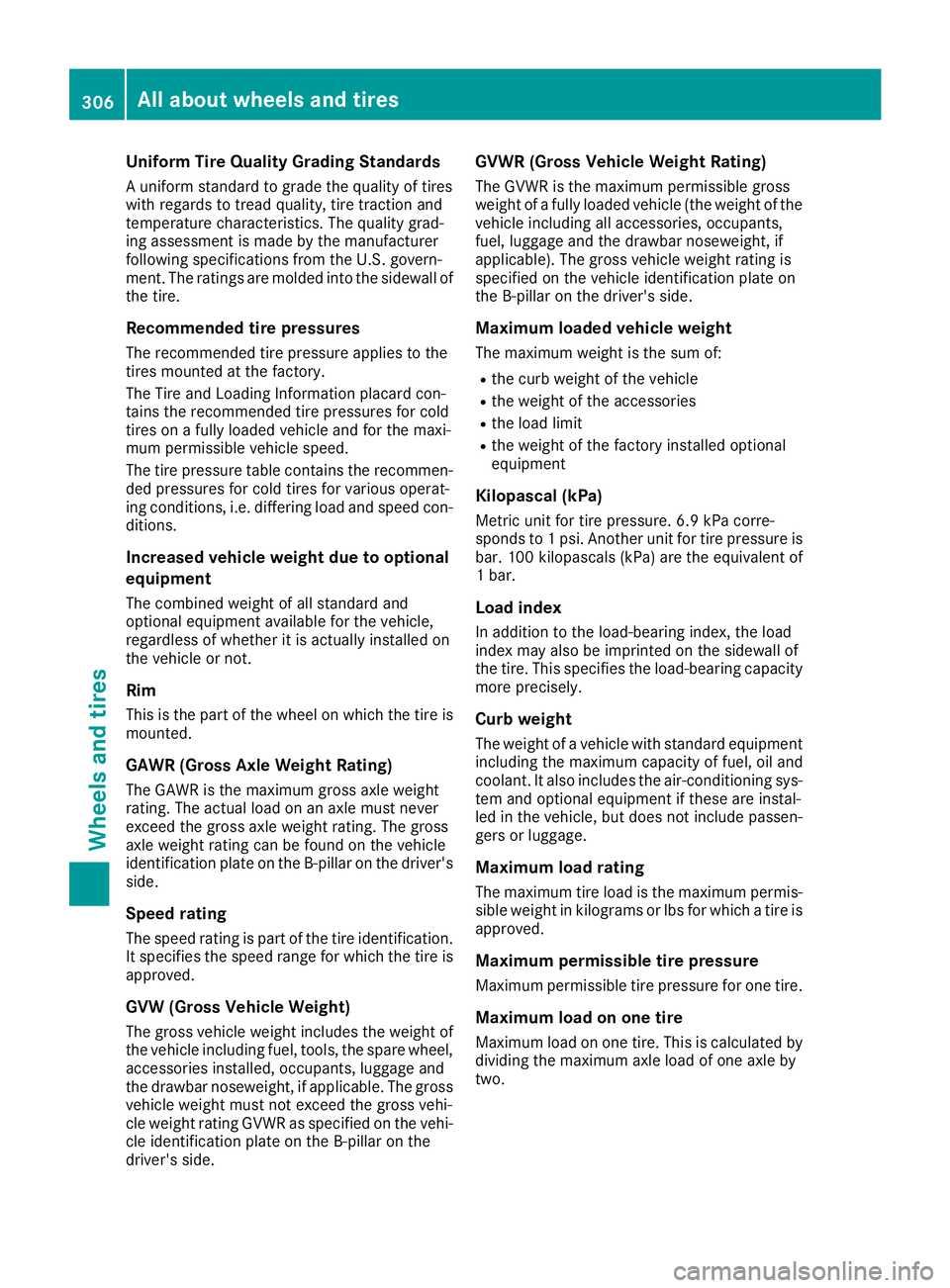
Uniform Tir eQ ualit yG rading StandardsAu nifor ms tandard to grade the quality of tires
with regards to tread quality, tire traction and
temperature characteristics. The quality grad-
ing assessmen tism ade by the manufacturer
following specification sf rom the U.S .g overn-
ment .T he ratings are molded int ot he sidewall of
the tire.
Recommended tir ep re ssuresThe recommended tire pressure applies to the
tires mounted at the factory.
The Tire and Loading Information placard con-
tains the recommended tire pressures for cold
tires on af ully loaded vehicle and for the maxi-
mum permissible vehicle speed.
The tire pressure table contains the recommen-
ded pressures for cold tires for various operat-
ing conditions, i.e. differin gl oad and speed con-
ditions.
Increased vehicle weight due to optional
equipment The combined weight of all standard and
optional equipment available for the vehicle,
regardless of whether it is actually installed on
the vehicle or not.
Rim This is the part of the wheel on which the tire is
mounted.
GAWR (Gross Axle Weight Rating) The GAWR is the maximum gross axle weight
rating. The actual load on an axle must never
exceed the gross axle weight rating. The gross
axle weight ratin gc an be found on the vehicle
identification plate on the B-pillar on the driver's
side.
Speed rating
The speed ratin gisp art of the tire identification.
It specifies the speed range for which the tire is
approved.
GVW (Gross Vehicle Weight)
The gross vehicle weight includes the weight of
the vehicle includin gf uel, tools, the spare wheel,
accessories installed, occupants, luggage and
the drawbar noseweight ,ifa pplicable. The gross
vehicle weight must not exceed the gross vehi-
cle weight ratin gG VWR as specified on the vehi-
cle identification plate on the B-pillar on the
driver' ss ide. GVW R( Gross Vehicle Weight Rating)The GVWR is the maximum permissible gross
weight of af ully loaded vehicle (the weight of the
vehicle includin ga ll accessories, occupants,
fuel, luggage and the drawbar n oseweight ,i f
applicable). The gross vehicle weight ratin gi s
specified on the vehicle identification plate on
the B-pillar on the driver' ss ide.
Maximum loaded vehicle weight The maximum weight is the sum of: R
the curb weight of the vehicle R
the weight of the accessories R
the load limit R
the weight of the factory installed optional
equipment
Kilopascal (kPa) Metric unit for tire pressure. 6.9 kPa corre-
sponds to 1p si. Another unit for tire pressure is
bar. 100 kilopascals (kPa) are the equivalent of
1b ar.
Load index In addition to the load-bearin gi ndex ,t he load
index may also be imprinted on the sidewall of
the tire. This specifies the load-bearin gc apacity
more precisely.
Curb weight The weight of av ehicle with standard equipment
includin gt he maximum capacit yoff uel, oil and
coolant .Ita lso includes the air-conditionin gs ys-
tem and optional equipment if these are instal-
led in the vehicle, but does not include passen-
gers or luggage.
Maximum load rating
The maximum tire load is the maximum permis-
sible weight in kilogram sorl bs for which at ire is
approved.
Maximum permissible tir ep re ssure
Maximum permissible tire pressure for one tire.
Maximum load on one tire
Maximum load on one tire. This is calculated by
dividing the maximum axle load of one axle by
two.306
All about wheels and tires
Wheels and tires
Page 314 of 326

Whee la nd tire combinations
General notes You can ask for information regarding permitted
wheel/tire combinations at an authorized
Mercedes-Benz Center.
You should regularl yc heck the pressure of the
emergency spare wheel, particularly prio rt o
long trips, and correct the pressure as neces-
sary ( Y
pag e2 90). The valu eont he wheel is
valid.
! For safety reasons, Mercedes-Benz recom-
mends that you only use tires and wheels
which have been approved by Mercedes-Benz
specifically for you rv ehicle.
These tires have been speciall ya dapted for
use with the control systems, such as ABS or
ESP ®
,a nd are marked as follows:R
MO = M ercedes-Benz OriginalR
MOE = M ercedes-Benz Original Extended
(tires featuring run-fla tc haracteristics)R
MO1 = M ercedes-Benz Original (only cer-
tain AMG tires)
Mercedes-Benz Original Extended tires may
only be use donw heels that have been spe-
cifically approved by Mercedes-Benz.
Only use tires, wheels or accessories tested
and approved by Mercedes-Benz. Certain
characteristics, e.g. handling, vehicl en oise
emissions or fuel consumption, may other-
wis ebea dversely affected .Ina ddition, when
driving with al oad, tire dimension variations
coul dc aus et he tires to come into contact
with the bodywork and axle components. This
coul dr esult in damage to the tires or the vehi-
cle.
Mercedes-Benz accepts no liability for dam-
age resulting from the use of tires, wheels or
accessories other than those tested and
approved.
Informatio nont ires, wheels and approved
combinations can be obtained from any quali-
fied specialist workshop.
! Retreaded tires are neither tested nor rec-
ommende dbyM ercedes-Benz, since previ-
ous damage cannot alway sbed etected on
retreaded tires. As ar esult, Mercedes-Benz
cannot guarantee vehicl es afety if retreaded
tires are mounted .Don ot mount use dt ires if
you have no information abo ut thei r previous
u
sage. The recommende dp ressures for various oper-
ating conditions can be found: R
on the Tire and Loading Informatio np lacard
on the B-pillar on the driver's side R
in the tire pressure tabl eint he fuel filler flap
Observe the notes on recommende dt ire pres-
sure su nder various operating conditions
( Y
pag e2 90).
Check tire pressures regularly ,a nd only when
the tires are cold. Comply with the maintenance
recommendations of the tire manufacturer in
the vehicl ed ocument wallet.
Notes on the vehicl ee quipment –a lway se quip
the vehicle: R
with tires of the same size on ag ive na xle (left
and right) R
with the same type of tire (summer tires,
MOExtended tires, winter tires)
Exception: it is permissible to instal lad iffer-
ent type or make in the event of af lat tire.
Observe the "MOExtended tires (tires with
run-fla tc haracteristics" section ( Y
pag e2 71).
Vehicles equipped with MOExtended tires are
not equipped with aT IREFIT kit at the factory .I t
is therefore recommende dt hat you additionally
equip you rv ehicl ew ith aT IREFIT kit if you mount
tires that do not feature run-fla tp roperties, e.g.
winter tires. AT IREFIT kit may be obtained from
aq ualified specialist workshop.312
Whee la nd tire combinations
Wheels and tires